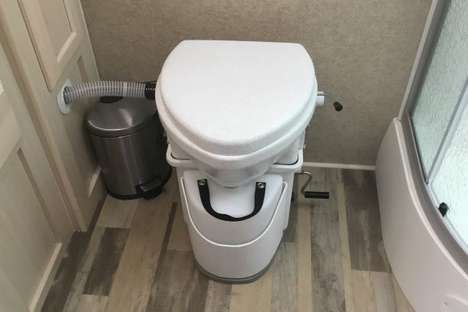In recent years, there has been a growing awareness of the environmental impact of our daily choices, prompting a shift towards more sustainable and eco-friendly lifestyles. One area where this shift is gaining momentum is in the realm of bathroom design, particularly with the emergence of waterless toilets. This article delves into the innovative waterless toilet revolution, exploring its benefits, challenges, and the potential it holds for a greener future.
The Need for Eco-Friendly Bathrooms:
As water scarcity becomes a global concern, the need for sustainable solutions in our daily routines becomes evident. Traditional flush toilets consume a significant amount of water with each use, contributing to water wastage.
The urgency to address this issue is further exacerbated by the fact that many regions worldwide are grappling with water scarcity issues.
Waterless toilets present a viable alternative, offering an eco-friendly option that reduces our overall water footprint.
How Waterless Toilets Work:
Waterless toilets utilize various mechanisms to process waste without the need for water. One common type is the composting toilet, which breaks down human waste into compost through natural processes.
Composting toilets use organic materials like sawdust or coconut coir to aid in the decomposition process, creating nutrient-rich compost that can be safely used as fertilizer.
Another type of waterless toilet employs innovative technologies like vacuum or incineration to dispose of waste efficiently. Understanding these mechanisms is crucial for embracing the waterless toilet revolution.
Benefits of Waterless Toilets:
a. Water Conservation: The most obvious advantage of waterless toilets is the conservation of water resources, contributing to sustainable water management. In comparison to traditional flush toilets, waterless systems can save thousands of gallons of water per household annually.
b. Energy Efficiency: Some waterless toilet technologies, such as incineration toilets, utilize energy to dispose of waste, offering an alternative to water-intensive systems. While there is an energy cost associated with these models, the overall environmental impact is often lower than conventional alternatives.
c. Reduced Environmental Impact: Waterless toilets minimize the environmental impact associated with wastewater treatment plants and the use of chemical-based cleaners. By eliminating the need for sewage infrastructure and reducing the use of harmful chemicals, waterless toilets contribute to a healthier ecosystem.
Overcoming Challenges and Misconceptions:
While waterless toilets offer numerous benefits, they are not without challenges and misconceptions. Common concerns include odor control, maintenance, and public perception.
Modern waterless toilet designs address these issues through advanced ventilation systems, effective sealing mechanisms, and user-friendly interfaces.
Ongoing research and development aim to dispel misconceptions and improve the overall user experience.
Implementation and Adoption:
The widespread adoption of waterless toilets faces challenges related to infrastructure, regulations, and societal acceptance. Retrofitting existing buildings and integrating waterless systems into new constructions require coordinated efforts between governments, municipalities, and private stakeholders.
Policymakers must explore regulatory frameworks that incentivize the adoption of eco-friendly technologies, and public awareness campaigns can play a pivotal role in overcoming societal hesitations.
Cost Considerations:
One significant barrier to the adoption of waterless toilets is the initial cost. High upfront expenses often deter individuals and businesses from making the switch. However, it’s essential to consider the long-term economic benefits, including reduced water and energy bills.
Governments and financial institutions can support this transition by providing incentives, tax credits, or financing options to make waterless toilets more accessible.
FAQs:
Q1:Are waterless toilets hygienic?
Yes, waterless toilets are designed with hygiene in mind, incorporating features like sealing mechanisms and ventilation systems to control odors and ensure a sanitary environment. Proper usage and maintenance are essential to uphold hygiene standards.
Q2:How often do composting toilets need maintenance?
Maintenance frequency depends on usage and model, but typically, composting toilets require attention every few weeks to months. Regular checks, proper waste management, and adherence to manufacturer guidelines are crucial for optimal performance.
Q3:Can waterless toilets be used in all climates?
Yes, waterless toilets are versatile and can be adapted for use in various climates. Proper insulation and ventilation adjustments may be necessary in extreme conditions to ensure consistent performance.
Q4:Are there any government incentives for installing waterless toilets?
Some regions offer incentives, tax credits, or rebates for adopting eco-friendly technologies, including waterless toilets. Check with local authorities for available programs, as these may vary depending on location and government policies.
Conclusion:
The waterless toilet revolution represents a promising step towards creating eco-friendly bathrooms and mitigating the impact of water consumption on the environment. While challenges and misconceptions exist, ongoing technological advancements, increased public awareness, and supportive policies can pave the way for a sustainable and water-conscious future. Embracing these innovations is not just a choice but a responsibility towards preserving our planet for future generations. As individuals, communities, and governments work collaboratively, the waterless toilet revolution can become a cornerstone in building a greener and more sustainable world.

A group of home improvement enthusiasts and bathroom design experts, combines in-depth knowledge and a shared passion to deliver engaging, informative content that guides readers through the world of bathroom innovation and style.

Leave a Reply